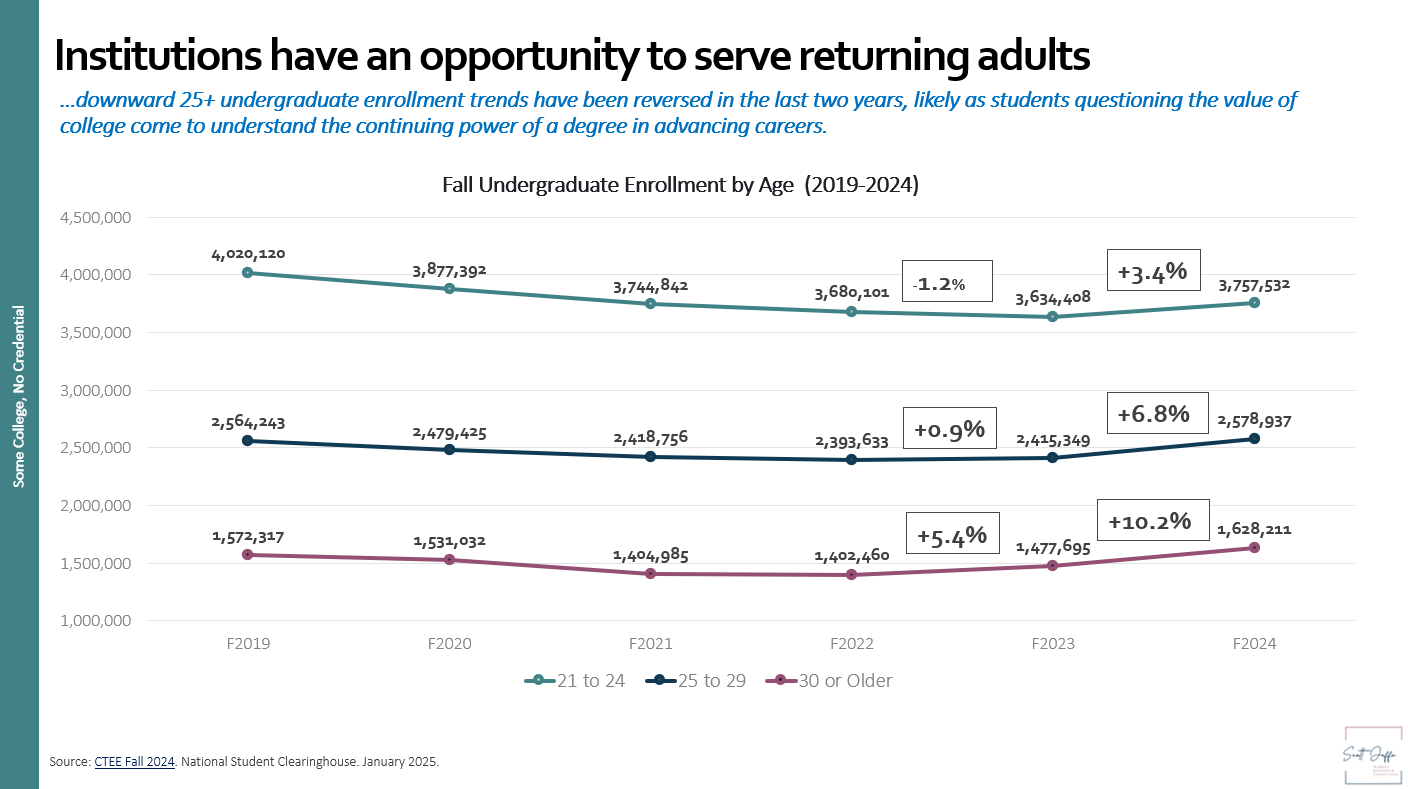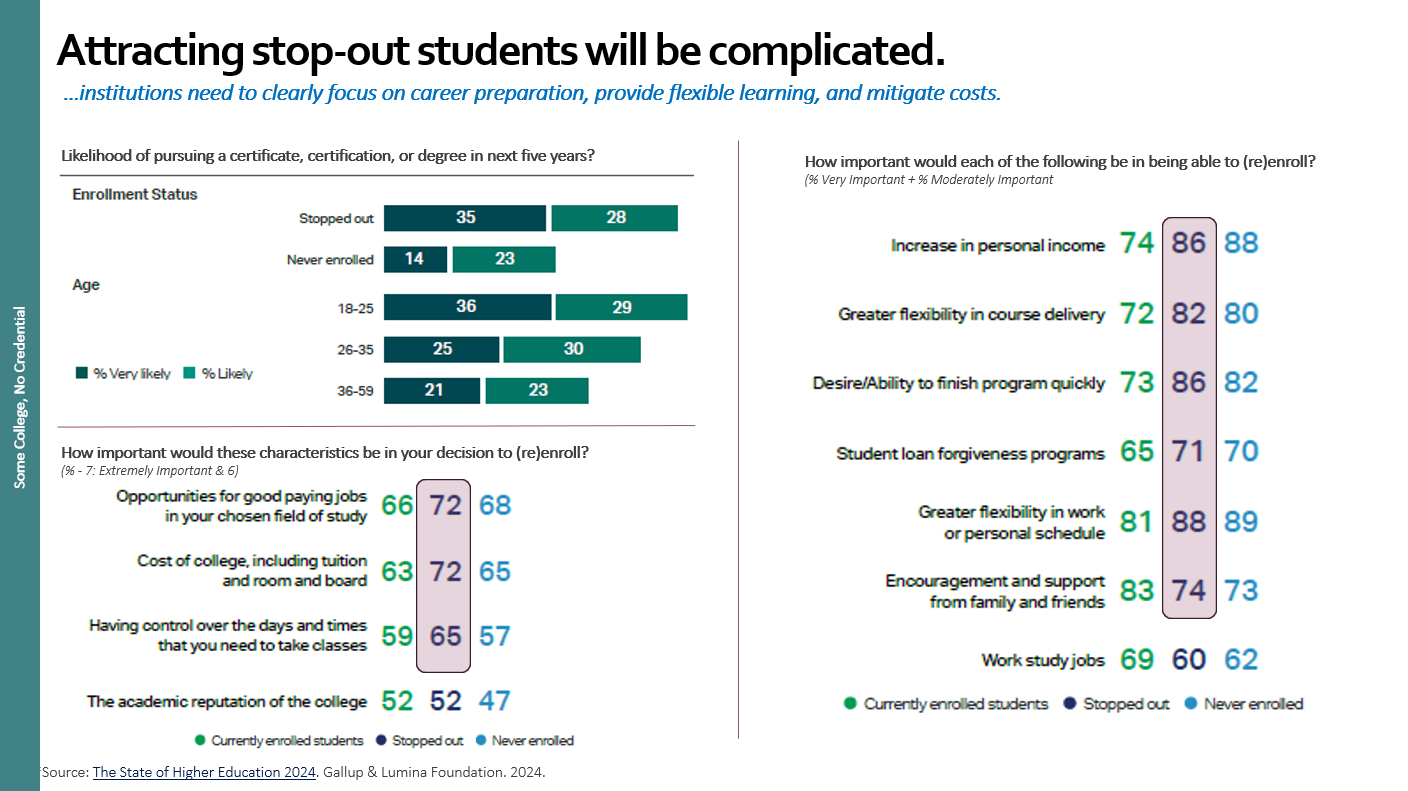
Growing "Some College, No Credential" Enrollment - 5 Ingredients for Success
Over the first years of my career - at the College Board - I immersed myself in the complexities of the “adult student” market, conducting dozens of market research studies to help colleges understand how to attract and serve adult learners in their communities. Each project culminated in a report filled with actionable, data-driven recommendations tailored to their specific market.
Today, this same audience—now labeled “some college, no credential”—is once again a priority for institutions looking to diversify their enrollment. Unlike the post-Great Recession era, when institutions last scrambled to expand their reach, the opportunity today is real. After more than a decade of declining undergraduate enrollment among students aged 25 and older, this segment is finally growing again. Here's the data:

Chart 1: National Student Clearinghouse trend data clearly indicates growth among "adult" learners.
The latest National Student Clearinghouse data indicate that, for the second year, tens of thousands of additional undergraduates over age 21 enrolled in study – with those 30+ increasing by 10.2 percent in Fall 2024. In total, 437,000 new adult students enrolled in the Fall of 2024. This follows more than a decade of contraction from the highpoint in 2011 (according to IPEDs data). This is being driven by two factors: 1) to paraphrase an old nugget “When the economy is perceived as bad, adults return to school”; and 2) the likelihood that some people who have recently told surveys that they question the value of college are realizing sooner than ever that they were wrong.
But here’s the thing: attracting, enrolling, and retaining these students is going to be complicated, will require serious rethinking of many of the “sacred cows”, and will require an investment of real dollars. Here are five core strategies that institutions will have to commit to in order to successfully attract their share of these “some college/no credential students:
1. Ensure generous transfer credit policies. A new survey from Public Agenda indicates that only one-third of undergraduates indicated that “most” of their previously earned credits transferred, 20 percent reported having to retake courses already completed, and 16 percent indicated that they decided not to enroll due to complicated transfer credit policies. If you think about these policies in terms of their economic impact on the student - who is already shouldering loan debt – it is clear just how important it is to accept every earned credit unless there is a regulatory, accreditation, or legal reason for not doing so. We cannot grow enrollment among this economically precarious population without acknowledging that every credit we deny is hundreds or thousands of dollars that will have to come out of their pocket.
2. Offer a reduced special tuition rate. Numerous recent surveys have indicated a decline in the confidence that earning a degree is worth the money. Many news stories, though, do not go beyond the headline. Nearly all these studies have a similar finding: confidence in the value of the degree declines precipitously among students who have had to take out loans, and among prospective students who have to contemplate doing so. Institutions seeking to grow their “some college/no credential” audience need to aim for a tuition rate that will result in no more student debt. One innovative president I know is meeting with donors to create a new fund to underwrite the gap for any student in need and positioning it as both a bridge to the future and an investment in regional economic development.

Chart 2: Gallup's State of Higher Education 2024 includes important data on stopped out students.
3. Every program must prepare students for their career. Twenty-five years ago, hundred of institutions had adult education units and they were often “cash cows.” The primary offering was typically a Bachelor’s in General Studies, which served the needs of a workforce that needed “a degree” for their next career step. Today, employers talk about needing employees who can think and communicate, but they rarely hire liberal arts graduates. While skills are an increasing focus, most HR teams still use the subject of the degree to select candidates. Students know this, and this why they flock to career-related programs and why the demand for experiential education is skyrocketing. One provost I know is incentivizing faculty to weave two professional certifications into every degree program. While you’re at it, be sure you have a clear “credit for life/work experience” policy that students can easily find.
4. Ensure your programs can be completed online. Back in the 1990s we told institutions they had to invest in an off-campus location. Main campus was inconvenient, parking was unsafe, and mixing adults with traditional students was intimidating. Today, that formula has changed considerably, but there is still a core investment that must be made: online education infrastructure. Just like buying or leasing the off-campus location, but with far more applicability to overall institutional sustainability. The pandemic had a particularly strong impact on student comfortability with all things online with 80 percent of online students now rating their online program as just as good as past classroom experiences, and with more than two-thirds of the online audience being aged 25+. So, institutions need to be sure that their “some college/no credential” efforts are anchored in online education with adequate surrounding support services that will help these students succeed.
5. Target students with appropriate services. NCS’s second report on the “some college” audience included perhaps the most important finding in this series: students returning with two years’ worth of credit are the most likely to complete their degree, making them the ideal audience for institutions. However, they represent only 10 percent of all “some college, no credential” students—leaving millions unserved. To support students with fewer credits, institutions must provide comprehensive wraparound services. This includes online orientation, readiness self-assessments, dedicated student support contacts, and AI-driven early warning systems to boost persistence. These students have the same expectations as their higher-credit peers but face greater challenges in staying enrolled. Institutions that prioritize structured, proactive support will see stronger retention and long-term success.
With nearly half a million new adults returning to undergraduate education in Fall 2024—and more on the way—there’s a real opportunity for institutions willing to make hard choices and strategic changes. But success won’t happen by chance.
As you reflect on these five fundamentals, how do they align with your institution’s current approach? Which feel like a natural fit, and which would require a heavier lift? Most importantly, what would it take to implement them effectively? Let’s talk. Whether you’re exploring small adjustments or a full-scale strategy, I’d love to help you develop a game plan for success. Reach out, and let’s start the conversation.